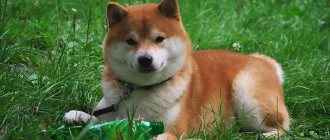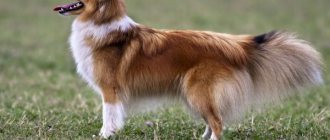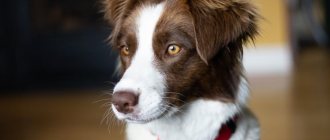History of the breed
Many modern dog breeds have Chinese roots, especially small and medium breeds. Shar Pei dogs also originated in ancient China, when it was ruled by the famous Qin Dynasty. Unfortunately, there is no reliable information about exactly how the first Shar Pei appeared.
There is a theory that all stud books and all documentary records about the process of breeding this breed were deliberately destroyed by Emperor Shi Huang. Scientists were unable to find out what the emperor’s goal was.
Based on anatomical similarities and general character traits, it can be assumed that the ancestors of the Shar Pei were ancient mastiffs and smooth-haired chow-chows. Using laboratory research, it was determined that the period of existence of Shar Pei dogs is three thousand years.
Initially, these dogs lived only in a few provinces of southern China.
Already in the 2nd century BC. e. Shar Peis have become the most popular breed among the country's population. During archaeological excavations in ancient tombs, clay figurines were discovered in the shape of a frowning dog, which is completely covered with folds. This breed was popular not only among the nobility; they were also often found in the homes of ordinary Chinese.
During the reign of the Communist regime, there was no place for Shar Pei dogs, like many other pets. Mao Zedong's supporters, like himself, considered pets unnecessary. Therefore, the mass extermination of cats and dogs began. The severity of World War II contributed to the almost complete disappearance of pets. According to official information, by the beginning of 50, there were only a few Shar Pei dogs left throughout China.
Only in the 70s did the first Shar Peis appear in Europe
Shar Peis amazed Europeans so much that they made it into the newspapers. Caring breeders began an active struggle for the revival of these dogs. They found eight purebred Shar Peis in the Chinese provinces, which became the basis for the revival of the breed.
To speed up the process of reviving the breed, crossings were carried out with other breeds that had similar appearance or character traits. It was possible to develop the first purebred pedigree only in the 76th year of the 20th century. In the same year, the official breed standard was approved. After this, Shar Peis actively spread throughout Europe and America. They came to Russia only at the end of the 20th century.
Shar Pei health and diseases
Unfortunately, dogs of this breed are prone to many diseases. The most common are: elbow dysplasia, luxating patella, hypothyroidism, eye problems, retinal dysplasia, glaucoma, allergic reactions and skin infections. A disease such as fever is especially common among Shar-Peis. A fever may be accompanied by vomiting, indigestion, rapid breathing, and even loss of consciousness. During a fever, the animal's temperature may rise greatly. It is not easy to completely get rid of this disease. But modern medicine offers some expensive treatments that promise to rid your pet of fever forever.
Breed standard
- Representatives of the ancient Chinese breed are characterized by a strong, dense build.
- At the same time, the dogs are mobile, active and sociable.
- The body shape resembles a square, the length of the back is almost equal to the height of the dog at the withers. This feature is more clearly expressed in males.
- The height at the withers of an adult male varies between 50 centimeters, the height of females varies from 45 to 51 centimeters.
- Shar Pei girls weigh from 18 to 25 kilograms, while males can weigh up to 35 kilograms.
- The dogs have a strong, broad back.
- The abdominal line is moderately tucked.
- The tail is placed high, at the tip it is thinner and curls.
- The length of the paws is average, they are smooth and not covered with folds.
- The head of these dogs is large and the skull is flat. The presence of folds in the forehead and cheeks forms a dewlap. This breed is characterized by the presence of a wide muzzle, which resembles a hippopotamus.
- The breed standard allows for a slight convexity near the nose. The animal's nose is quite large with wide nostrils. Its color can be black or pink.
Shar Pei: description
The Shar Pei dog breed is a medium-sized, strong and powerful molossoid type animal. The distinctive feature of the breed is its black-blue tongue and skin, which is found on the animal’s body in the form of folds formed on the head and withers in adults, and throughout the body in puppies. Shar Peis are smart, strong and active dogs that lead an active lifestyle.
Breed standards
Shar Pei dogs have a fairly compact, but at the same time strong build, although the body format of males is more square, and females are more elongated. Weighing from 18 to 35 kilograms, the height of males is 49-51 cm, and females – 44-49 cm. Despite the fact that the dog’s head is massive and large, it looks harmonious against the background of the entire physique. The muzzle is wide and powerful, while the transition from it towards the frontal part is quite noticeable, but not so pronounced. According to breed standards, the length of the muzzle should correspond to the length of the skull, but there are quite a lot of dogs of this breed whose muzzle is somewhat shortened.
On the muzzle and on the frontal part of the head, as well as on the cheeks, there are deep folds of skin that turn into a suspended state. High above the eyes are small, triangular-shaped ears. In some individuals they are so small that they practically do not cover the ear canal. The nose is painted black, or to match the color of the coat, and it is large and wide. The upper lip is quite thick and massive, causing it to droop, overlapping the lower lip, so that only part of the chin can be seen.
Breed standards do not allow for an incomplete set of teeth, as well as an incorrect scissor bite. The tongue and palate have a black-bluish tint if the dog has a classic coat color. If individuals do not have such a rich coat color, then the tongue and palate have a characteristic lavender color. The eyes can be oval or almond shaped, with the iris as dark as possible. The animal should have a calm, alert look. The neck is small, arched, although slightly, with slight dewlap at the bottom. It should not be massive and heavy so as not to impede the animal’s freedom of movement.
The chest area is quite deep and voluminous, and it reaches the elbow joints. The back is also wide and powerful, and the loin is somewhat convex, with a transition to a sloping croup. The abdominal area does not have a sharp bend, so it is considered moderately toned. The limbs do not look massive, but they are muscular and strong. The forelimbs are set evenly and parallel, therefore quite straight. The hind legs are also muscular, set wide apart, with low hocks.
The tail is round and thick at the base, set high and gradually tapering towards the end. Three options for the location of the tail are allowed: curled into a tight single or double ring, hanging down to one side, as well as a tail curled into an incomplete ring, located at a short distance from the back. The coat is short, but dense and quite tough.
It is important to know! The coat can be quite short and stiff, with guard hair up to 1 cm long, called “horse”, as well as “brush”, with guard hair up to 2 and a half centimeters long, softer and more elastic. A Shar Pei with a bear-hair coat pattern is considered a breed fault.
The main characteristic of the breed is the nature of the skin, which looks like folds. This is especially true for puppies, since such folds are located throughout their body. In adults, such folds should be on the forehead, muzzle, cheeks and neck. Their presence on other parts of the body is undesirable, although their presence is not considered a fault of the breed. Folds on the limbs of adults are considered unacceptable, although a similar defect is inherent in dogs of extreme types.
Coat color
Natural standards allow any single-color coat color, with the exception of pure white. Shar Pei colors can be both basic and weakened. The main colors are associated with the presence of a black base color of the nose, lips, eyelids, paw pads, as well as the presence of a darker color of the muzzle. Weakened colors are associated with the absence of black pigment, as a result of which the nose and other characteristic parts of the body are colored brown. It should also be noted that the darker tones on the face also have a brown tint rather than black.
- The main colors are black, blue, isabella, fawn, sable, red and cream.
- The weakened ones include chocolate, apricot, lilac, weakened cream, weakened sable and weakened isabella.
It is important to note! Dogs with primary coat colors are characterized by a black-blue, purple or bluish tongue color, while Shar-Peis with subdued coat colors have a lighter tongue.
Dog character
These dogs are characterized as intelligent and quick-witted animals, with an easy-going, peaceful character. Being in a home environment, Shar Peis relate well to all family members, including children, taking part in children's games and entertainment. Despite the fact that these dogs are affectionate and playful, they do not lack a sense of self-esteem, nobility and majesty. These dogs have not lost their guarding skills, so they are always vigilant and wary. Thanks to these qualities, Shar-Peis are distrustful of strangers, as well as other people's dogs, showing excessive aggressiveness. This character trait often greatly influences the process of training and education.
How long do Shar Peis live?
On average, these dogs can live from 8 to 12 years, although with proper care and a well-organized diet, these terms can be considered conditional, since life expectancy can increase significantly. This factor is significantly influenced by illnesses suffered at an early age, as well as by improper and irresponsible keeping of the animal.
✔ Shar Pei is an amazing dog with folds on the skin, a wide muzzle and a dark tongue
Appearance and coat colors of the Shar Pei
- A distinctive feature of Shar-Pei dogs is their frowning gaze.
- The eyes are dark in color.
- The ears are small, triangular in shape with rounded tips.
- Due to their fighting qualities, dogs have strong, well-developed jaws.
- The color of the tongue, palate and gums is a shade of blue.
- The main feature of Shar Pei dogs is the presence of folds of skin.
- The body is covered with short bristly hair, the hairs are stiff, and there is no undercoat.
basic information
| Breed name: | Shar Pei |
| Country of origin: | China |
| Time of origin of the breed: | 3,000 years ago |
| Type: | mountain and Swiss cattle ranches |
| Weight: | 18 – 35 kg |
| Height (height at withers): | 44 – 51 cm |
| Lifespan: | 9 – 11 years |
| ICF classification: | Group 2, Section 3, Number 309 |
| Price of puppies: | 150 – 450 $ |
| The most popular nicknames: | list of nicknames for sharpei |
The types of coats of Shar-Peis can be divided into the following categories:
- Horse hair (horse).
- Brush-shaped (brush).
- "Bear fur."
The breed standard allows for many color variations. The most common colors are black, cream, fawn, mahogany (reddish), blue, isabella, and sable. In addition to the main color, the animals have black pigment spots similar to a mask and a belt on the back.
A color with no black spots is allowed.
- Cream.
- Apricot.
- Chocolate.
- Lilac color.
There are also dogs of non-standard colors:
- Spotted.
- Black-and-brown (black-brown).
In the first option, the main color is white, on which specks are placed. With the saddle color, the back is black and the tan marks are light in color.
Shar Pei character
It is worth noting that this breed has a complex temperament and pronounced leadership qualities. Therefore, caring for and raising a Shar Pei is not an easy task. It is not recommended to have such a dog for people who lack self-confidence, lack leadership qualities, or have a fear of dogs.
And also the dog may not find a common language with small children and other animals living in the house. From the first minute in a new home, the Shar Pei requires proper education and training.
Despite his small size, he will try to win the leadership position. If the owner proves himself to be a strong “leader,” the dog will become his most faithful and devoted friend. Shar Peis can be infinitely kind and affectionate.
The character of the Shar Pei is complex, but the breed also has many positive qualities . Such a pet is an excellent watchman and security guard. What is important is that he will greet a stranger with a loud, threatening bark, but will never make unnecessary noise for no reason.
The main feature of the Shar Pei is culture and restraint. These dogs are not intrusive, even during outdoor games. Owners of Shar Pei puppies confirm the high intelligence of their pets. They follow the rules clearly established by the owner, are well oriented in the area, and remember the road. Dogs are characterized by restraint, balance and devotion.
Price examples
If we delimit the territory of the Russian Federation by region, we will get the following cost diagram for Shar Pei puppies:
- Moscow region: 15,000-55,000 rubles .
- Krasnodar region: 10,000-35,000 rubles .
- Sverdlovsk region: 5,000-25,000 rubles .
- Nizhny Novgorod region: 10,000-30,000 rubles .
- Republic of Tatarstan: 10,000-35,000 rubles .
Finding a Shar Pei puppy is a real problem in Kaliningrad and the Far Eastern District, where prices for the breed can reach 70,000 rubles .
Care and maintenance
Due to their compact size and cleanliness, Shar Peis are suitable for keeping in private homes and apartments. Animals easily endure long trips in the car.
Two walks a day will be enough for them. In the summer, it is not recommended to take your pet outside from 11 to 17 pm, as the heat will cause them discomfort.
If you choose these animals, caring for them will not cause you any trouble. Shar Peis do not like water, but they need to be bathed once every 2 months. Trim your nails every month. Clean your ears once a week with cotton swabs.
Teaching your puppy the rules of behavior must begin from the first days. It is worth clearly identifying the things you can play with, and be consistent and categorical in your prohibitions. Dogs are smart enough, so there are no problems with training. But during classes there is no need to put pressure on the animal. It is worth showing the task and giving the dog time to comprehend it. Under no circumstances should you hit a dog. The use of force will instill anger and uncontrollability in the Shar Pei.
Training and education
The most important thing you need to train a Shar Pei is patience. These dogs are capricious creatures, so they are not entirely happy with attempts to force your opinion on them. Perseverance, systematicity and rewards for following commands should become your faithful companions during the entire learning and training process. Shar Peis are not the type of dog that is recommended to new dog owners. If you have never owned a dog, it is better to choose a different breed.
Composition and nutritional standards
An adult dog will only need one or two meals a day. Puppies up to three months need three feedings, and up to six months – two. It is worth remembering that Shar Pei under the age of six months can only be fed wet food or dry food soaked in broth. Dry food is more convenient because it contains all the necessary vitamins and minerals, but choose high-quality brands.
If you decide to stick to a natural diet, then your diet will be something like this:
- Rice porrige.
- Lean meat in raw form.
- Sea fish fillet (pre-scald with boiling water).
If desired, you can diversify the menu with vegetables, fruits, eggs and dairy products are occasionally allowed. But do not forget that Shar Peis have an innate tendency to allergies, so give new foods in small portions.
Character
The Shar Pei has a greater variety of personalities than most modern breeds. This is the result of the fact that dogs were often bred for profit, without regard for character. Lines with good heredity have a predictable character, the rest are a matter of luck.
These dogs form strong relationships with their family members, often demonstrating unprecedented loyalty. However, they are also very independent and freedom-loving. This is not a dog that follows its owner around.
She shows her love, but does it discreetly. Since the Shar Pei is prone to dominance and is not easy to train, the breed is not recommended for beginners.
For hundreds of years, this dog was kept as a guard and watchman; it is naturally distrustful of strangers. Most are extremely wary of them; a rare Shar Pei will greet a stranger.
However, even if they are not delighted, they are quite polite and rarely show aggression towards strangers.
Most people get used to new family members over time, but some ignore them for the rest of their lives. Socialization plays an important role; without it, aggression towards a person can develop.
Despite the fact that today they are rarely used for security and watchdog service, the breed has natural inclinations for it.
This is a territorial breed that will not allow strangers to enter their domain.
Most Shar Peis are calm with children if they have been socialized. In practice, they adore the children in their family and are close friends with them.
However, it is extremely important that the child respects the dog, as they do not like to be rude.
In addition, special attention should be paid to those dogs that have difficulty seeing due to folds of skin. They often have no peripheral vision and sudden movement frightens them. Like any other breed, the Shar Pei, if not socialized, can react negatively to children.
The biggest behavioral problems arise from the fact that Shar Peis do not get along well with other animals. They have high aggression towards other dogs; it is best to keep one dog alone or with a person of the opposite sex. Although they are not usually looking for a fight (not all of them are), they are quick to anger and will not back down. They have all forms of aggression towards dogs, but territorial and food aggression are especially strong.
In addition, they are no less aggressive towards other animals. Most Shar Peis have a strong hunting instinct and will regularly bring the carcass of a torn cat or rabbit to their owner.
They will try to chase down and strangle almost any animal, regardless of its size. Most can be trained to tolerate indoor cats, but some will attack and kill at the slightest opportunity.
Shar Peis are quite intelligent, especially when it comes to solving a problem. When they are motivated to learn, everything goes quickly and easily. However, they rarely have the motivation and instead have a reputation for being a difficult breed to train.
Although they are not particularly stubborn or headstrong, Shar Peis are stubborn and often refuse to follow commands. They have an independent mindset that does not allow them to carry out a command at the first call. They expect something in return and training with positive reinforcement and treats works much better. They also quickly lose concentration because they get bored with the monotony.
One of the biggest problems is the nature of the Shar Pei, which causes him to challenge the leadership role in the pack. Most dogs will try to take control if they are allowed to. It is important for the owner to remember this and take a leadership position at all times.
This all means that raising a manageable dog will require time, effort and money, but even the most well-mannered Shar Peis are always inferior to a Doberman or Golden Retriever. It is better to walk them without letting them off the leash, since if a Shar Pei chases an animal, it is almost impossible to get it back.
However, they are of average energy, for many a long walk is quite enough and most families will satisfy their exercise requirements without problems. Even though they love to run around in the yard, they can adapt well to living in an apartment.
At home they are moderately active and spend half the time on the couch and half moving around the house. They are considered excellent dogs for apartment living for a number of reasons. Most Shar Peis hate water and avoid it at all costs.
This means that they avoid puddles and mud. In addition, they are clean and take care of themselves. They bark extremely rarely and quickly become toilet trained, many times earlier than other breeds.
What do Shar Peis get sick with?
Despite good health, representatives of the Shar Pei breed are prone to certain diseases, namely:
- Pathology of the eyes and ears.
- Skin diseases (dermatitis).
- Thyroid gland dysfunction.
- Tumors of internal organs.
To protect your dog from serious illnesses, when the first symptoms appear (an unpleasant putrid odor from the skin, poor appetite or refusal to eat, decreased physical activity), contact your veterinarian.
This breed has a fairly strong innate immune system and good health, but the pet needs to be vaccinated regularly. By providing proper living conditions in an apartment or private house, you guarantee a long life for your four-legged friend. The average lifespan of the Shar Pei breed is 12 years.
Assessing the Characteristics of the Shar Pei Breed
| Adaptability (a definition that refers to how easily a dog can adapt to changes in life) |











